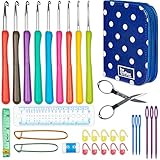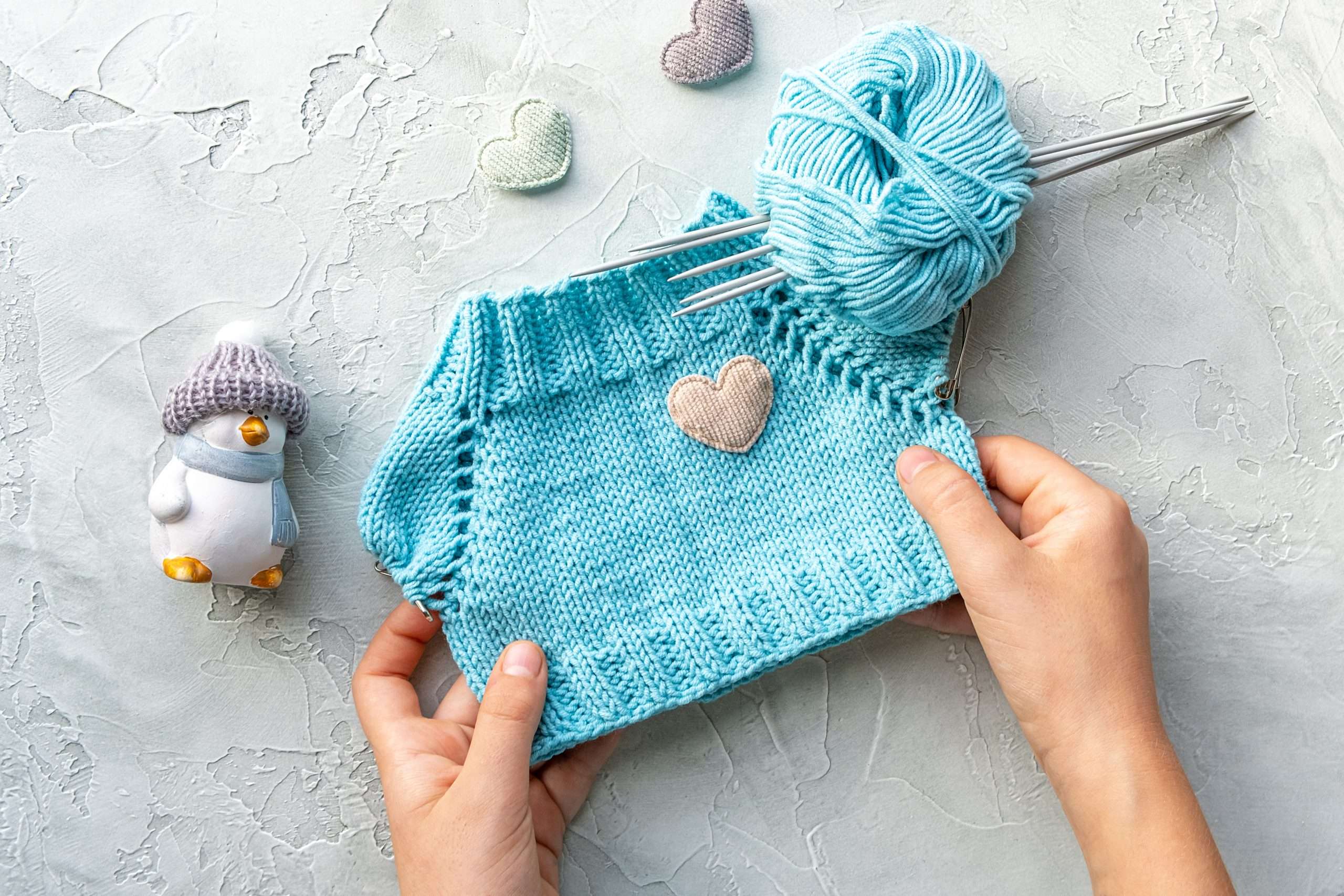Winter is here, and if you are like me, we all just want to cozy up inside and stay warm. These negative wind chills here in Michigan are hard to get used to this week, and I have no desire to leave the house for anything! When I saw the forecast, I admittedly had visions of hot coffee, quiet reading time, and a bunch of handwork. The twins might not share that idea with me, but hey, we are trying haha. My vision for this week is a perfect way to ease our way into the new school semester. And since we are all still just a bit under the weather and recovering from colds, it seems even more fitting.
If you have never given knitting or crocheting a chance, this is a great time to add it to your homeschool. Now that the holidays are over, I think we are all craving some calm and simple days. January really is the best time ever to pick up this craft.
When M was 7, she learned how to knit for the first time. In first grade, she made a knit ball stuffed with a little bell inside, a stuffed lamb, and even a little gnome among many other things. She learned to knit as part of the curriculum in the Waldorf school she attended. I love that she had the opportunity to learn to knit at such a young age. Back when she was first learning, I thought it was such a good idea but, I had no idea how it would affect her in years to come.
M is now 10 and has been knitting and crocheting for a few years. I have had the privilege to see the short and long-term (in the matter of a few years later anyway) benefits of kids learning to knit and crochet, and I wanted to share them here because I think they are pretty significant.
Here are 5 big benefits of adding knitting and crochet to your homeschool this winter:
1. Stress relieving
Knitting and crocheting are calming activities for kids and grown-ups. Many psychologists have studied the topic and believe that knitting lowers blood pressure. The repetitive patterns and motions are calming. Especially for those with ADHD.
2. Educational benefits
When kids learn to knit for the first time, they are working in rows from left to right. This is the same pattern they use in reading and the reason why in Waldorf schools, knitting is taught before reading! It is a skill that promotes concentration, attention, fine motor skills, and patience. All of which are essential for learning reading and math. As kids knit, they learn to become aware of patterns in their handwork which is also crucial for reading and math as they can also learn how to identify patterns in these subjects.
Additional benefits include: learning to follow directions and using both sides of the brain as you use both right and left hands.
3. Teaches perseverance
Last year, M announced she wanted to make a crochet baby blanket for her new baby cousin. She was so proud to work on such a beautiful gift and was so motivated to finish it as a visit with the new baby quickly approached. She worked so hard on that blanket as it was a big project for her to complete. I remember the morning she finished it (just in time for us to meet the new baby). As she finished the border, her happiness turned to sadness. When I realized what had happened, I felt bad for her. She had grown so attached to the project and so connected to her work; she just didn’t know if she could give it away. She spent hours, weeks, on this amazing crochet baby blanket and she had never given away anything she made that took this much time. We told her she did not have to give it away and it was totally fine. There were other gifts for the new baby.
When my sister came over with the new baby, M brought the folded blanket to them and presented the gift. She had decided herself it was what she wanted to do and although it was hard for her, she felt so proud of the gift she had made and given. In the end, she felt really good about it. Since then, she has made lots of things for friends and family, and every time she gifts something that she has created, she feels so proud and satisfied with her accomplishment and the ability to give something useful to someone else. I believe it brings her happiness and satisfaction. Not only does it require perseverance to complete a project but once completed, it also becomes something they are so proud to have made. It is a beautiful thing for our kids to learn and feel.
4. Teaches patience
There is no immediate gratification when you knit or crochet. Instead, it requires coming back to it time and time again and gradually working towards a completed project. It takes time to make things. It takes patience to stick with something and see it through to the end. It takes patience for kids when stitches are skipped, or mistakes happen. Sometimes the hardest thing about knitting something is when you must take out some of the work and redo some stitches or start over. These are not easy lessons for kids to learn, but they are so incredibly valuable.
It was interesting to me last year when M announced that she was ready to make an Afghan. Ha! yes, my then 9-year old wanted to make herself a crochet blanket. I was a bit skeptical that it would be just another project that was started and not finished. How could a 9-year-old have the perseverance to see through such a big project? I knew It would take a long time to complete and I thought for sure she would get bored or discouraged quickly. She started the Afghan last winter and worked on it here and there throughout the winter last year. Every time she finished a big chunk of it, she was so proud of herself. It turns out; she didn’t have to finish it quickly for it to become a considerable accomplishment. She has set that Afghan aside and picked it back up again from time to time. It is still a work in progress, as it is about half done now. Every time she gets motivated to work on it, she gets a little farther, and that is a pretty satisfying accomplishment to her.
5. A great activity for quiet time
Especially when in the learning phase, knitting and crochet take concentration. Because of this, it is a wonderful activity for adding quiet downtime into your homeschool day. I often hold the baby’s nap time as sacred afternoon quiet time. During this time, we read, or M works on her handwork projects. I know many families do handwork during read-aloud time, which is also an excellent way for little hands to stay busy and focussed while filling their heads with literature.
Another way to incorporate knitting and crocheting is to start the day with this quiet calm activity. For some kids who take a bit of time to warm up to doing traditional lessons in the morning, this can be a great way to start the day. Sometimes just the focus and relaxation that comes from knitting can be a game-changer when it’s time to sit and do math. Play around with what time of day works for your family and pay attention to how incorporating it at different times of the day affects the outcome of the following activities you do.
Resources
M first learned to knit in the Waldorf School. Since learning to knit, she picked up crochet pretty easily on her own. She had a bit of help with crochet initially from my Grandma and has recently taken another knitting class with some friends. However, aside from these real-life teachings, almost every stitch and project in the past two years has been learned from watching youtube knitting and crochet how-to videos. Youtube can be a really great place to start. After getting the basics done, there are a few kids’ books we got pretty early on. M has enjoyed making some of the projects out of them.
This Kids Knitting book was recommended by our Waldorf handwork teacher as the best knitting book out there for kids. M has enjoyed making several of the projects in it.
| Preview | Product | Price | |
|---|---|---|---|

|
Kids Knitting: Projects for Kids of all Ages |
$10.99 |
Buy on Amazon |
We started using bamboo knitting needles as they are not as slippery and easier to hold when first learning. Alex Toys make a good kit if you are just starting because they use big wooden needles.
| Preview | Product | Price | |
|---|---|---|---|

|
ALEX Toys DIY Wear Knit and Wear | Buy on Amazon |
We also really like these knitting needles for teaching kids to knit. These are great because when working with young kids it can be helpful to explain the position of the blue needle in contrast to the red needle until the movements become more fluid.
| Preview | Product | Price | |
|---|---|---|---|

|
Lion Brand Yarn 7 Inch, Size 10 Knitting Needles for Kids |
$11.60 |
Buy on Amazon |
We really like these crochet kits with hooks that are a little nicer to hold. M likes them because she says they are not as slippery in your hand. Plus they have a handy little storage case which is super helpful.
| Preview | Product | Price | |
|---|---|---|---|

|
BeCraftee Crochet Hooks Kit - 31 Piece Set with 9 Ergonomic Hook Sizes, 6 Yarn Needles, Additional... | Buy on Amazon |
I’d love to hear your thoughts about knitting and crocheting with kids and your thoughts about adding it to your homeschool day. Please feel free to join in on the conversation.
Additional books to read
If you are looking to really get young kids excited about knitting, there are a bunch of fun picture books to enjoy.





Last update on 2024-07-27 / Affiliate links / Images from Amazon Product Advertising API


